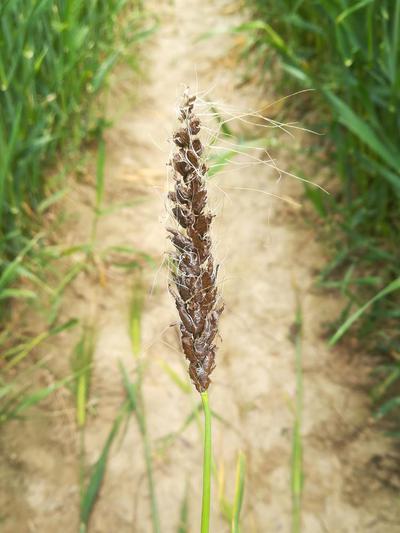Loose Smut of Wheat
Ustilago segetum var. tritici
Fungus
In a Nutshell
- Symptoms appear shortly before or during flowering stage.
- Blackened heads with powdery black grains and a peculiar "dead fish" odor.
- The developing kernels are replaced by fungal growth.
Can also be found in
Symptoms
Symptoms appear shortly before or during flowering stage and are characterized by blackened heads with powdery black grains and a peculiar "dead fish" odor. The developing kernels are replaced by fungal growth and no grains develop in the infected heads. It is a common disease throughout the wheat-growing regions of the world. The yield loss on infected heads is total.
Recommendations

Organic Control
Soak the seeds in 20-30°C water for 4-6 hours. Afterwards, dip them into 49°C hot water for 2 minutes. In the next step place the seeds on plastic sheets and expose them to sunlight for another 4 hours. The seeds should be completely air dried before sowing. This treatment reduces the infection risk. but it might affect the germination rate of the seeds.

Chemical Control
Always consider an integrated approach with preventive measures together with biological treatments if available. Seeds can be treated with systemic fungicides such as carboxin or triadimenol, which are taken up by the germinating seed and hold in check or kill the fungus within the seed. An array of other compounds is available to treat the seeds, among others, triticonazole, difenoconazole and tebuconazole.
What caused it?
The symptoms are caused by the seed-borne fungus Ustilago tritici, that survives in a dormant state within infested wheat seeds. The development of the fungus keeps pace with the life cycle of the plant. When the infested seed germinates, the fungus resumes growth along the shoots of the young wheat plants and eventually colonizes the tissues of the flowers. Instead of releasing pollen, the flowers disperse fungal spores that are spread by the wind to healthy flowers. There, they germinate and start to colonize the internal tissues, eventually being incorporated into new seeds. The infested seeds carry the dormant fungus but appear healthy. The cycle will start over again with the planting of these seeds. Other means of dispersal include harvest residues, rain and insects. Favorable conditions for the rapid germination of the spores are humid weather (60-85% relative humidity) with frequent rains or dews and cool temperatures between 16–22°C.
Preventive Measures
- Use seeds from healthy plants or from certified disease-free sources.
- Plant resistant varieties if available.
- Make sure to clean tools, hands and footwear when working on different fields.



